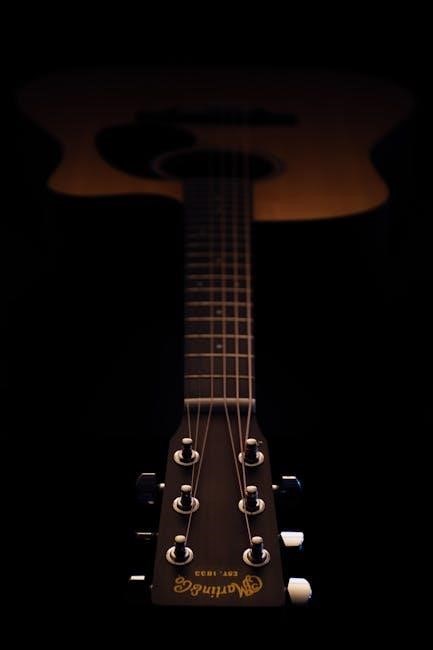
guitar scale pdf
Guitar scales are fundamental for musicians․ They are used for technique‚ improvisation‚ and understanding music theory․ This section introduces the concept of guitar scales and highlights the availability of PDF resources․

Why Practice Guitar Scales?
Practicing guitar scales is essential for any aspiring guitarist․ Scales serve as very useful exercises to develop technique and coordination․ Scales are the foundation for becoming a learned musician‚ rather than merely a recreator․ They are essential building blocks for being able to improvise․
The foundation of many aspects of guitar playing rests in learning and practicing scales․ By diligently practicing scales‚ guitarists improve their finger dexterity and overall technique․ The importance of scales for lead guitarists cannot be overstated․ Scales help improve your lead guitar skills․
Understanding scales allows guitarists to play over jazz standards‚ and other styles of music․ Scales are essential for beginning jazz guitarists․
Scales also help you learn the fretboard․ Scales are essential building blocks for improvisation․ Regular practice is key to mastering scales and unlocking their potential․

Essential Scales for Beginners
For beginners‚ mastering a few essential scales is crucial․ The Major Scale and Minor Pentatonic Scale are great starting points‚ building a solid musical foundation and leading to improvisation․
Major Scale
The Major Scale‚ often referred to as the Ionian mode‚ is the cornerstone of Western music theory․ It provides a foundation for understanding melodies‚ harmonies‚ and chord progressions․ Its bright and cheerful sound makes it exceptionally popular in various musical genres․ Learning the Major Scale involves understanding its intervallic structure: whole‚ whole‚ half‚ whole‚ whole‚ whole‚ half steps․
Guitarists can explore the major scale across the fretboard using different patterns and positions․ Mastering these patterns allows for fluid movement and improvisation․ There are multiple PDF resources available online that offer detailed diagrams and tablature for learning the major scale in all twelve keys․ Practicing the Major Scale regularly enhances finger dexterity‚ improves fretboard knowledge‚ and unlocks countless musical possibilities․ Understanding and internalizing the Major Scale is essential for any aspiring guitarist․
Minor Pentatonic Scale
The Minor Pentatonic Scale is a five-note scale widely used in blues‚ rock‚ and many other genres․ Its simplicity and versatility make it a favorite among guitarists for soloing and improvisation․ Characterized by its characteristic “bluesy” sound‚ it omits the 2nd and 6th degrees of the minor scale․ The formula for the minor pentatonic scale is: 1‚ b3‚ 4‚ 5‚ b7․
This scale is extremely forgiving and sounds good over a variety of chord progressions․ Guitarists often start with the minor pentatonic scale due to its accessibility and immediate gratification․ PDF resources are abundant‚ providing diagrams for various positions on the fretboard․ Practicing these positions will allow guitarists to move freely across the neck․ The Minor Pentatonic Scale is an essential tool for any guitarist looking to create expressive solos․
Blues Scale
The Blues Scale is an extension of the minor pentatonic scale‚ adding one crucial note: the flat 5th (b5)‚ often referred to as the “blue note”․ This addition creates the characteristic dissonance and tension that defines the blues sound․ The formula for the blues scale is: 1‚ b3‚ 4‚ b5‚ 5‚ b7․
This scale is widely used in blues‚ rock‚ and jazz music․ It is a powerful tool for creating expressive and emotive solos․ The inclusion of the b5 adds a unique flavor and allows guitarists to explore a wider range of sounds․ PDF resources for the blues scale are readily available‚ providing diagrams for various positions and keys․ Mastering the blues scale opens up a vast world of musical possibilities for guitarists․ Practice is key to integrating this scale into your playing․
Understanding Scale Diagrams
Scale diagrams are visual representations of scales on the guitar fretboard․ They help guitarists learn and visualize scale patterns․ Understanding these diagrams is crucial for mastering scales․
Reading Fretboard Charts
Fretboard charts are essential tools for guitarists․ They visually represent the guitar’s fretboard‚ showing the position of notes and scales․ Understanding how to read these charts is crucial for learning and applying scales effectively․ The horizontal lines represent the strings‚ with the thickest string (low E) usually at the bottom․ Vertical lines indicate frets․
Dots on the chart show where to place your fingers to play the scale․ Numbers inside the dots may indicate suggested fingerings․ Familiarize yourself with the fretboard layout to quickly locate notes․ Use these charts to learn scale patterns in different positions․ This will significantly improve your ability to play scales and improvise․
Fretboard charts are available in PDF format for easy access and printing․ Practice reading and interpreting these charts regularly to enhance your understanding of scales․
Scale Positions and Patterns
Understanding scale positions and patterns is key to mastering guitar scales․ Each scale can be played in multiple positions on the fretboard․ Learning these positions allows you to move seamlessly between different areas of the neck‚ expanding your playing possibilities․ Scale patterns are the specific sequences of notes that make up a scale within a given position․
These patterns are often visualized as shapes on the fretboard․ By memorizing these shapes‚ you can quickly play a scale in any key․ Practice transitioning between different scale positions to develop fluidity and dexterity․ Using PDF resources with scale diagrams can be very helpful for visualizing and learning these patterns․
Focus on understanding the relationships between the notes within each pattern․ This will not only improve your technique but also enhance your understanding of music theory․

Free Printable Guitar Scale PDFs
Accessing free printable guitar scale PDFs is a valuable resource for guitarists of all levels․ These PDFs typically contain diagrams of various scales in different keys and positions‚ making them an excellent reference tool for practice and learning․ Many websites offer these resources‚ often including common scales like major‚ minor pentatonic‚ and blues scales․
These printable charts allow you to easily visualize scale patterns on the fretboard․ They can be used as a quick reference guide during practice sessions or as a study aid for memorizing scale shapes․
Be sure to look for PDFs that include clear diagrams and‚ ideally‚ tab notation to help you understand the finger placement for each scale․ Some resources may also offer tips on how to use the scales in improvisation․ Utilizing these free PDFs can significantly enhance your understanding and mastery of guitar scales․
Comprehensive Guitar Scales Chart Books
For guitarists seeking an extensive collection of scales and arpeggios‚ comprehensive guitar scales chart books are invaluable․ These books‚ often available as printable PDFs‚ offer a vast array of scales‚ modes‚ and arpeggios in various keys and positions on the fretboard․ They serve as a detailed reference for both beginners and experienced players․
These chart books typically include diagrams‚ notation‚ and sometimes even tablature‚ providing multiple ways to learn and understand each scale․ Many also feature explanations of music theory concepts related to scales‚ such as how they are constructed and used in different musical contexts․
A good comprehensive scale chart book will cover major‚ minor‚ pentatonic‚ blues‚ and modal scales‚ as well as more advanced scales used in jazz and other genres․ Investing in such a resource can greatly expand your musical knowledge and improve your ability to improvise and create interesting guitar parts․
Jazz Guitar Scales
Jazz guitar demands a deeper understanding of scales beyond the basic major and minor․ Jazz guitar scales are essential for improvising over complex chord progressions and creating the sophisticated melodies characteristic of the genre․ These scales often include altered notes and chromaticism to add color and tension to the music․
Some essential jazz guitar scales include the bebop scales‚ altered scales‚ and various modes of the melodic minor scale․ These scales provide the tools to navigate the intricate harmonies found in jazz standards․ Learning jazz scales involves understanding their relationship to chords and how to use them to create compelling solos․
Many resources offer scale charts and exercises specifically for jazz guitar․ These resources often include examples of how to apply the scales in real-world musical situations․ Mastering jazz guitar scales is a crucial step in becoming a proficient jazz guitarist․

Using Scales for Improvisation
Scales are the bedrock of improvisation․ They provide the framework for creating melodies and solos that fit within the harmony of a song․ Understanding how to use scales effectively is crucial for any guitarist looking to improvise․
When improvising‚ it’s essential to know which scales work best over different chord progressions․ For example‚ the minor pentatonic scale is often used for blues and rock improvisation‚ while major scales and their modes are suitable for major key progressions․ Jazz improvisation requires a more extensive knowledge of scales‚ including bebop scales and altered scales․
Beyond simply knowing the notes in a scale‚ it’s important to understand how to use them musically․ This involves creating phrases‚ using dynamics‚ and incorporating techniques like bends and slides․ Experimenting with different scales and listening to how they sound over various chords is a great way to develop your improvisational skills․ Remember to use the scales as a tool to express your musical ideas and create engaging solos․
Expanding Your Scale Knowledge
Mastering a few basic scales is a great starting point‚ but the journey doesn’t end there․ Expanding your scale knowledge opens up new musical possibilities and enhances your understanding of the fretboard․ Explore different types of scales‚ such as modal scales‚ harmonic minor‚ and melodic minor․
Modal scales‚ also known as modes‚ are variations of the major scale that create unique melodic flavors․ Harmonic and melodic minor scales offer different approaches to minor key melodies and harmonies․ These scales introduce new intervals and melodic possibilities compared to the natural minor scale․
Delving into more advanced scales‚ such as altered scales and bebop scales‚ can add sophistication to your playing‚ especially in jazz and fusion genres․ Altered scales are derived from the seventh mode of the melodic minor scale and are used to create tension and dissonance․ Bebop scales add an extra note to pentatonic or major scales‚ creating a more flowing and melodic sound․